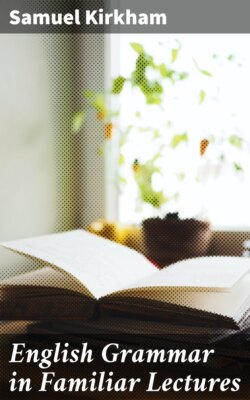Читать книгу English Grammar in Familiar Lectures - Samuel Kirkham - Страница 31
На сайте Литреса книга снята с продажи.
INDICATIVE MOOD, PRESENT TENSE.
Оглавление| Singular. | Plural. |
| 1. Per. I walk, | 1. Per. We Walk, |
| 2. Per. Thou walkest, | 2. Per. Ye or you walk, |
| 3. Per. He walks, or the boy walks, or walketh. | 3. Per. They walk, or the boys walk. |
This display of the verb shows you, that whenever it ends in est, it is of the second person singular; but when the verb ends in s, or eth, it is of the third person singular. Walkest, ridest, standest, are of the second person singular; and walks or walketh, rides or rideth, stands or standeth, are of the third person singular.
I have told you, that when the nominative is singular number, the verb must be; when the nominative is plural, the verb must be; and when the nominative is first, second, or third person, the verb must be of the same person. If you look again at the foregoing conjugation of walk, you will notice that the verb varies if its endings in the singular, in order to agree in form with the first, second, and third person of its nominative; but in the plural it does not vary its endings from the first person singular. The verb, however, agrees in sense with its nominative in the plural, as well as in the singular. Exercise a little mind, and you will perceive that agreement and government in language do not consist merely in the form of words. Now, is it not clear, that when I say, I walk, the verb walk is singular, because it expresses but one action? And when I say, Two men walk, is it not equally apparent, that walk is plural, because it expresses two actions? In the sentence, Ten men walk, the verb walk denotes ten actions, for there are ten actors. Common sense teaches you, that there must be as many actions as there are actors; and that the verb, when it has no form or ending to show it, is as strictly plural, as when it has.—So, in the phrase, We walk, the verb walk is first person, because it expresses the actions performed by the speakers: Ye or you walk, the verb is second person, denoting the actions of the persons spoken to; third person, They walk. The verb, then, when correctly written, always agrees, in sense, with its nominative in number and person.
At present you are learning two parts of speech, neither of which can be understood without a knowledge of the other. It therefore becomes necessary to explain them both, in the same lecture. You have been already informed, that nouns have three cases; the nominative, the possessive, and the objective.
POSSESSIVE CASE. The possessive case denotes the possessor of something; as, This is John's horse. This expression implies, that John is the owner or possessor of the horse; and, that horse is the property which he possesses.
When I say, These are the men's, and those, the boys' hats, the two words, "boys' hats," plainly convey the idea, if they have any meaning at all, that the boys own or possess the hats. "Samuel Badger sells boys' hats." Who owns the hats? Mr. Badger. How is that fact ascertained? Not by the words, "boys' hats," which, taken by themselves, imply, not that they are Mr. Badger's hats, nor that they are for boys, but that they are hats of, or belonging to, or possessed by boys. But we infer from the words connected with the phrase, "boys' hats," that the boys are not yet, as the phrase literally denotes, in the actual possession of the hats. The possession is anticipated.
In the phrases, fine hats, coarse hats, high-crowned hats, broad-brimmed hats, woollen, new, ten, some, these, many hats, the words in italics, are adjectives, because they restrict, qualify, or define the term hats; but the term boys' does not describe or limit the meaning of hats. Boys', therefore, is not, as some suppose, an adjective.
"The slave's master." Does the slave possess the master? Yes. The slave has a master. If he has him, then, he possesses him;—he sustains that relation to him which we call possession.
A noun in the possessive case, is always known by its having an apostrophe, and generally an s after it; thus, John's, hat; the boy's coat. When a plural noun in the possessive case, ends in s, the apostrophe is added, but no additional s; as, "Boys' hats; Eagles' wings." When a singular noun ends in ss, the apostrophe only is added; as, "For goodness' sake; for righteousness' sake;" except the word witness; as, "The witness's testimony." When a noun in the possessive case ends in ence, the s is omitted, but the apostrophe is retained; as, "For conscience' sake."
Now please to turn back, and read over this and the preceding lecture three times, and endeavor, not only to understand, but, also, to remember, what you read. In reading, proceed thus: read one sentence over slowly, and then look off the book, and repeat it two or three times over in your mind. After that, take another sentence and proceed in the same manner, and so on through the whole lecture. Do not presume to think, that these directions are of no real consequence to you; for, unless you follow them strictly, you need not expect to make rapid progress. On the other hand, if you proceed according to my instructions, you will be sure to acquire a practical knowledge of grammar in a short time.—When you shall have complied with this requisition, you may commit the following order of parsing a noun, and the order of parsing a verb; and then you will be prepared to parse or analyze the following examples.
